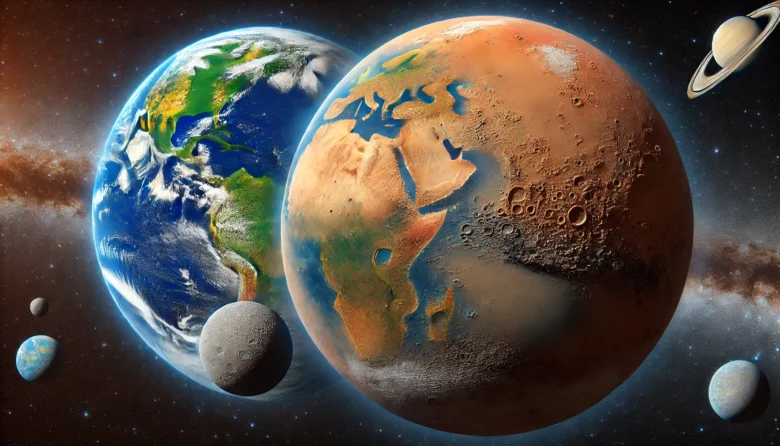Have you ever gazed up at the night sky and wondered what lies beneath the surface of those distant planets? The field of planetary geology offers us the key to unlocking these mysteries. By studying the geological processes and structures of planets like Mars, scientists gain insights not only into the history and composition of these celestial bodies but also into the very processes that shaped our own Earth. In this blog, we will dive into “The Science of Planetary Geology: Mars and Beyond,” exploring how this fascinating field helps us understand our solar system and what lies in the vastness beyond.
The Foundations of Planetary Geology
Planetary geology is a branch of science that focuses on the geology of celestial bodies, including planets, moons, asteroids, and comets. It examines surface features, such as mountains, valleys, craters, and plains, and the internal composition of these bodies. This field has expanded our knowledge of the solar system by revealing the processes that shape planetary surfaces, such as volcanic activity, tectonics, erosion, and impact cratering.
Mars, often called the “Red Planet,” has been a primary focus of planetary geology. Its surface is a treasure trove of geological features that tell the story of its past. For example, the vast Valles Marineris canyon system stretches over 4,000 kilometres (2,500 miles), making it one of the largest canyons in the solar system. This feature is a testament to the tectonic forces that once shaped Mars.

Mars: A Window into Planetary Evolution
Mars is unique in many ways, and its geology has provided scientists with invaluable insights into planetary evolution. Unlike Earth, Mars does not have active plate tectonics, which means its surface has remained relatively unchanged for billions of years. This makes it an excellent record of the planet’s history.
Olympus Mons, the highest volcano in the solar system, is one of Mars’ most fascinating geological features. Standing at a staggering 22 kilometers (13.6 miles) high, Olympus Mons dwarfs Mount Everest and offers clues about volcanic activity on Mars. Scientists believe that the planet’s lower gravity and lack of tectonic movement allowed Olympus Mons to grow to such immense proportions.
Additionally, the presence of dried-up riverbeds and mineral deposits on Mars suggests that liquid water once flowed on its surface. These findings have significant implications for the possibility of past life on Mars and have driven numerous missions to explore the planet further.
Beyond Mars: Exploring Other Celestial Bodies
While Mars has been a focal point, planetary geology extends beyond the Red Planet. The study of other celestial bodies like the Moon, Venus, and asteroids has also yielded fascinating discoveries.
The Moon, Earth’s closest neighbour, has a geology that tells the story of its violent past. The numerous impact craters that dot its surface are evidence of the early solar system’s chaotic environment. The Apollo missions brought back lunar samples, allowing scientists to study the Moon’s composition and gain insights into the formation of the Earth-Moon system.
Venus, often referred to as Earth’s “sister planet,” has a surface covered with vast volcanic plains and a thick atmosphere. The extreme conditions on Venus, including temperatures hot enough to melt lead, make it a challenging environment to study. However, radar mapping from spacecraft like NASA’s Magellan has revealed the planet’s complex geology, including evidence of volcanic and tectonic activity.
Asteroids, the rocky remnants from the early solar system, are another focus of planetary geology. Missions like NASA’s OSIRIS-REx have provided valuable data about the composition and history of these small bodies, which are considered the building blocks of planets.
The Future of Planetary Geology
The future of planetary geology is bright, with numerous missions planned to explore the solar system further. NASA’s Perseverance rover is currently on Mars, exploring Mars to find evidence of ancient life and gathering samples for eventual return to Earth. The European Space Agency’s (ESA) upcoming missions to Jupiter’s moon Europa aim to explore its icy surface and the potential subsurface ocean, which may harbor life.
Technological advancements, such as enhanced radar and imaging techniques, are enabling scientists to examine planetary surfaces with unprecedented detail. As planetary geology continues to evolve, it will further illuminate the processes that shape our solar system and other planetary systems beyond.
Conclusion
Planetary geology offers us a glimpse into the dynamic processes that have shaped not only our planet but also the countless celestial bodies that orbit our Sun. From the towering volcanoes of Mars to the cratered surface of the Moon, each planet and moon has its own story to tell. As we continue to explore “The Science of Planetary Geology: Mars and Beyond,” we deepen our understanding of the universe and our place within it. Who knows what discoveries lie ahead as we venture further into the cosmos?
Author’s Note
Exploring the geology of other planets is like piecing together a cosmic puzzle. Each new discovery enhances our understanding and appreciation of the intricate and interconnected nature of our solar system.
G.C., Ecosociosphere contributor.





Comments
Thank you I have just been searching for information approximately this topic for a while and yours is the best I have found out so far However what in regards to the bottom line Are you certain concerning the supply